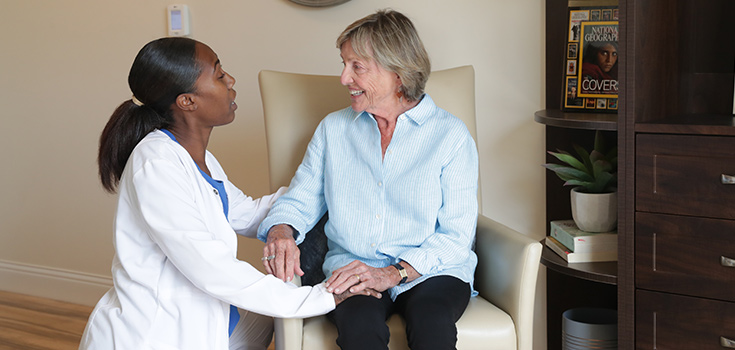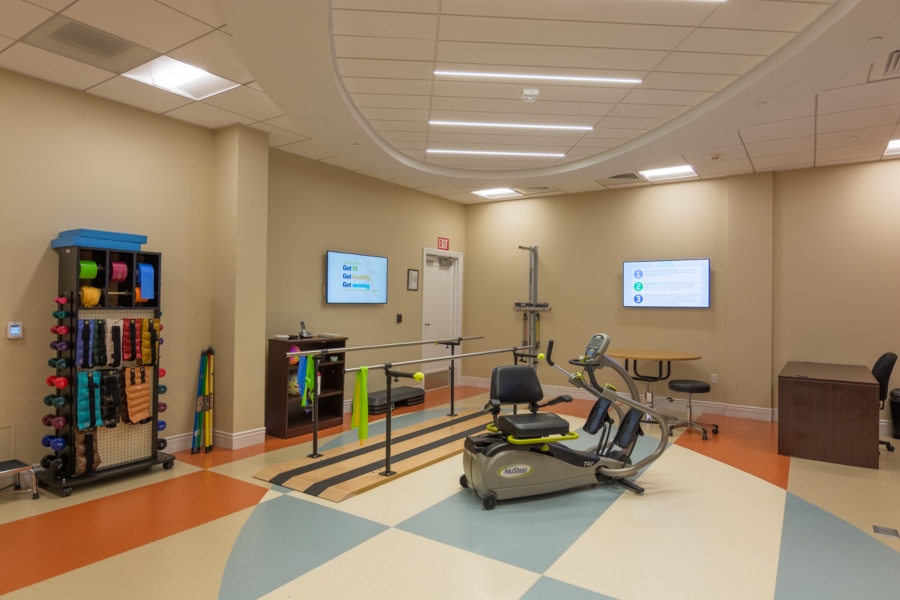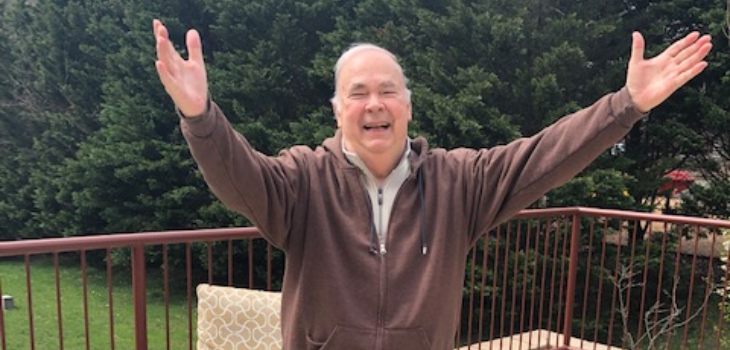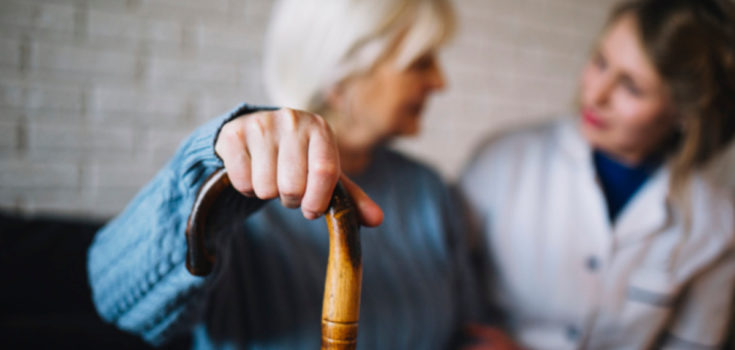Kids fall and pick themselves up all the time—running around on the playground, finding their balance on scooters and bikes, and rushing to keep up with friends. It is part of the natural growing process to fall and rise again, growing stronger each time.
However, there comes a time in life when fall risk can pose a real danger. According to the Centers for Disease Control (CDC), falls are the leading cause of injury-related death for adults 65 years of age and older. One in four Americans over 65 takes a fall each year. It is a subject that warrants attention.
By understanding the causes and risks associated with falls, seniors and their families can be more prepared to prevent them. In the event a fall does occur, there are steps that can be taken for more effective recovery.
Note: The Content is not intended to be a substitute for professional medical advice, diagnosis, or treatment.
Causes of Falls
Physical Ailments
Several pre-existing medical conditions can put seniors at a higher risk of falling. One of the most common is diabetes. High blood sugar can injure nerves throughout the body, especially in the legs and feet. This results in weakness, numbness, tingling, or even loss of feeling altogether. Diabetes can lead to ulcers and wounds on the feet, further affecting one’s ability to stand.
Symptoms of Parkinson’s can diminish balance. Tremors, impaired movement, and muscle rigidity all lead to greater difficulty. Alzheimer’s can also impair spatial recognition, causing unfamiliarity with surroundings.
Unrelated orthopedic injuries can contribute to fall risk. Broken or strained knees, hips, and feet make it difficult for anyone to walk.
Medication Side Effects
Medication side effects can be tough to predict, as different people have different reactions. With any change in medication regimen, changes to balance and stamina should be monitored.
Blood pressure medication, beta-blockers, and cholesterol medication can induce dizziness, lightheadedness, and loss of balance.
At Linden House Assisted Living at Branchlands, we always review our residents’ medication plans carefully. Whenever possible, if we find medication is causing unwanted side effects, we will investigate with the physicians to select another option.

Environmental Factors
On the brighter side, many environmental factors that contribute to falls can be mitigated or avoided. Some of the most insidious dangers are throw rugs and bathroom rugs. Their edges can easily catch unsuspecting canes, walkers, and toes. Moreover, all of us can be forgetful at times as to where we place household items. It’s important to keep walkways clear of tripping hazards.
Risers are a handy tool to minimize risk: place them under beds, furniture, and even on the toilet to decrease the distance it takes to bend over or sit down. The shower can also pose a slippery challenge. Accordingly, shower benches and handheld nozzles are a safer choice to reduce slip factors.
Uneven walking surfaces like outdoor paths, curbs, and even escalators bear caution. In view of obstacles like these, proper footwear should be selected to provide ample traction and arch support.
One final environment factor is lighting. As eyesight tends to dim with age, depth perception becomes more challenging. A well-lit residence is best for reducing fall risk. Even a small light can make a big difference!

Impacts of Falls
Physical Impact
“The fall itself is not so bad. It’s the sudden stop at the bottom that’s the problem.”
Falls can lead to broken bones, decreased mobility, and in the worst-case scenario, death. Broken bones, especially hips, are alarming for a number of reasons. Surgery can involve weeks to months of recovery time and lost independence: seniors’ bodies simply may not be able to handle the anesthesia and trauma of operations. Moreover, skin integrity can suffer over long recovery periods.
Injuries to the head can also induce significant cognitive impairments, comparable to those sustained from football players’ repeated impacts. Injuries to the arms and shoulders can make simple chores like getting dressed and bathing much more difficult.
Psychological Impact
Loss of independence is a legitimate fear for anyone, including seniors. A fall may jeopardize their ability to drive, shop, and complete other daily activities. As a result, they may hide a minor fall from loved ones, which can impede them from seeking needed treatment.
The pain of the fall itself can make seniors more fearful, causing them to become less mobile. This results in an unfortunate Catch-22. The answer to falling is not to stay put. Immobility also leads to decreased balance and strength, which in turn increases fall risk.
What’s more, the issue of pride comes into play. Social situations become more worrisome. Nobody wants to slip and fall in front of friends while out and about. This apprehension can cause seniors to stop attending the activities they enjoy.
Impact on Loved Ones
Family members and caregivers can also face difficulties as a result of falls. Foremost, it can be gut-wrenching to see loved ones lose independence, health, and confidence. Rehabilitation can take a toll on families. Not all families are equipped to provide total care for their aging loved ones, and that’s okay. At Branchlands, we are proud to provide the care needed for aging with grace and dignity.
Fall Prevention and Recovery
Exercise

The best treatment is to simply avoid injury in the first place. Many simple, effective steps can reduce fall risk.
First of all: walking! A normal walking regimen, about 2.5 hours per week, or 30 minutes per weekday, keeps strength, stamina, and balance in good standing. Also, exercises such as calf raises, heel walks, and stretching can keep ankles limber.
The Smovey exercise system is an excellent resource to improve coordination and stimulate muscles. Pictured above, Smovey consists of a spiraled tube, steel balls, and a cushioned grip. It can be used in standing swinging exercises, walking routines, and with partners for pushing and pulling.
Mental exercises are essential to staying sharp as well. Seniors should stay engaged with social activities, games and puzzles, and all the other normal activities enjoyed throughout life.

Rehabilitation
A three-pronged rehab approach for fall prevention and recovery involves physical, occupational, and speech therapy. Branchlands is proud to partner with Genesis Rehab Services, offering outpatient rehab at Linden House Assisted Living.

Physical Therapy
Physical Therapy is key for maintaining balance and strength. It helps patients deal with the pain of an injury and allows them to develop the endurance needed to get back on their feet.
The best approach is to focus on functional abilities: simple things like transferring items from surface to surface, and walking on different kinds of terrain. It’s also beneficial to work on endurance training, walking for specific periods or distances towards a goal. These tasks can be daunting for seniors who have experienced a fall.

Occupational Therapy
Occupational Therapy can help seniors adapt to the changes happening in their bodies. It involves care and training for functional daily activities, anything from hygiene to housework to leisure activities. Regaining competence with basic tasks leads to confidence that affects overall health, and stamina. Even crafts like painting and creating collages can help improve muscle control and restore optimism.
Speech Therapy
It may not seem obvious at first, but speech therapy can be an important step to recovery as well. Speech therapy rebuilds connections in the brain that relate to problem-solving, judgment, and cognition. Refreshing these abilities can improve perception and spatial awareness, boosting balance and recovery.
Technology
There are many technological resources that can keep us on our feet. For example, devices like electronic blood pressure monitors and oxygen trackers can detect symptoms before they become apparent.
Music can be a simple, yet powerful, resource. Music activates the brain, sparking neural pathways that control balance, confidence, and spatial awareness. Some seniors may not often have the strength to walk across a room, but put on a waltz and they’re up and dancing!
At Branchlands, we use a handy app called Clock Yourself to increase cognitive sharpness. Users take steps around the face of an imagined clock on the floor, keeping in time with a beat. For an added challenge, we can relate a specific month of the year to each number around the clock.
Using a pedometer to track steps can increase motivation by introducing goal-setting and competition among friends. At Branchlands, we’ll sometimes run step competitions, tracking who can first complete the 1,710 steps it takes to get to the top of the Eiffel Tower.
Wrapping Up
Fall injuries can significantly impact quality of life. However, there is reason aplenty to be hopeful. Strategies such as regular exercise, careful home organization, and use of technology can minimize fall risk. In the event a fall does occur, rehab and emotional support can go a long way to getting seniors back on their feet.
Above all, a fall is no reason to despair or submit to a life of immobility. The wisdom first expressed by Abraham Lincoln rings true still today: “It’s not about how many times you fall, but how many times you get back up.”
To learn more about our assisted living options, read on about living life to the fullest at Linden House.

Many thanks to Ashley Poe, Director of Rehabilitation at Genesis Rehab Services, for providing information for this blog!
